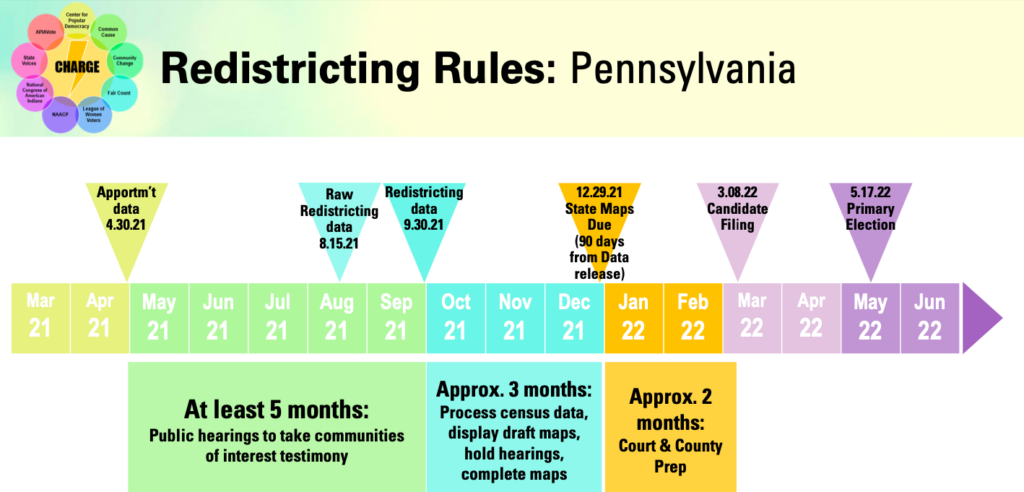Every ten years, Pennsylvania redraws its federal, state, and local legislative district maps. This process is meant to ensure that as populations grow and change, every Pennsylvanian can have equal representation and equal voice in government.
We’re fighting for fair, transparent, and equitable redistricting at every level — advocating for legislation like the Freedom to Vote Act to end partisan gerrymandering, bringing Pennsylvanians to testify at public hearings, and making sure that Pennsylvania’s new maps fairly represent all of our communities.
Redistricting in Pennsylvania
In Pennsylvania, Congressional redistricting is controlled by the state legislature, while a five-member commission draws state legislative lines.
In The State Legislative Redistricting Process, the majority and minority leaders of the PA House and Senate appoint four members to the Legislative Reapportionment Commission. These four members then have 45 days to vote on a fifth member to be the chair. If they can’t agree in this time, the PA Supreme Court appoints the chair instead.
The maps drawn by the LRC are not subject to approval from either the state legislature or the governor. Instead, the Commission has full control over the mapping process.
In The Congressional Redistricting Process, the U.S. Census population data is used to determine how many seats each state gets in the U.S. House of Representative. Once our legislators know how many Congressional districts we will have, they redraw district lines to make sure those districts are as equal in population as possible.
They then pass these maps as a bill — it must be approved by the PA House and Senate before going to the governor’s desk, where the governor can approve or veto.
When partisan politicians control the mapmaking process, we’re especially vulnerable to gerrymandering — which is why it’s so important we push our lawmakers to be transparent and consider public testimony every step of the way.
Districts must comply with the provisions of the US Constitution and Voting Rights Act and keep districts reasonably equal in population. In addition, mapmakers must prioritize:
- Keeping communities of interest and political subdivisions whole.
- Compactness
- Maximizing the number of politically competitive districts
Districts may not be drawn:
- To protect one or more incumbents, declared candidates, or political parties.
- With intent or effect of denial/abridgement of voting rights or vote dilution because of race or membership in a language minority group.
Why Redistricting Matters for Pennsylvania
When done fairly, redistricting is a chance for political power to be equitably distributed across different communities, making sure everyone has a seat at the table.
Unfortunately, redistricting has historically been conducted behind closed doors with little to no public input, meaning they don’t have an accurate picture of what our communities look like.
Even worse, when politicians have the power to draw electoral maps, they manipulate district lines to divide or pack together certain populations, keeping themselves and their party in power. It’s called gerrymandering – and it’s a major threat to our democracy.

Key Dates For Pennsylvania 2021 Redistricting
Hearings are held across Pennsylvania from May through September to take testimony from communities of interest. When the legislature receives the federal Census data, they use it in combination with public input to create draft maps.
From October through December, the legislature processes the data, displays draft maps, and holds hearings to get public feedback to revise the maps. After that, the Congressional draft maps are finalized, voted on by the state legislature, and sent to the Governor’s desk, who can veto or approve.
The first round of hearings in Pennsylvania has already passed! As we enter the next phase of redistricting, hearing dates will be posted at the state website, https://www.redistricting.state.pa.us/commission/hearings#schedule. To give in-person testimony at an upcoming hearing, please email contact@redistricting.state.pa.us.

Key Dates
- Raw Redistricting Data 08/15/2021
- Redistricting Data 09/30/2021
- State Maps Due 12/29/2021
- Candidate Filing 03/08/2022
- Primary Election 05/17/2022

Pennsylvania Redistricting Resources
Use these resources to learn more about how you can get involved in fighting for fair districts and stopping gerrymandering in Pennsylvania.